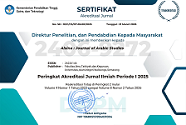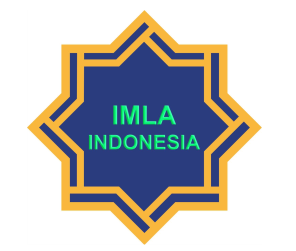Integration of Arabic Language Curriculum in Salaf and Khalaf Islamic Boarding Schools
Abstract
This study aims to analyze the design and impact of the integration of Arabic language curricula between the salaf and khalaf pesantren approaches in the Arabic Language Program at Madrasah I’dadiyah Salafiyah Syafi’iyah Sukorejo Situbondo. This integration is carried out in response to the challenges of contemporary Arabic education, which requires mastery of classical texts as well as modern communication skills. Using a descriptive qualitative approach, data were collected through observation, in-depth interviews, and document analysis involving the curriculum, teachers, students, and institutional management. The results of the study indicate that the integrative curriculum successfully combines the strengths of the salaf pesantren—which emphasizes the understanding of classical Islamic texts (kitab kuning)—with the advantages of the khalaf pesantren, which focuses on communicative competence. The pedagogical approaches employed include the sorogan, bandongan, hiwar, muhadatsah, and qirā’ah methods, all of which have proven effective in enhancing students’ abilities in both understanding Islamic texts and actively using the Arabic language. Substantively, this curriculum has produced graduates who are adaptive, communicative, and ready to compete in both academic and global arenas. This research provides both conceptual and practical contributions to the development of a contextual and sustainable pesantren-based Arabic language curriculum.
Downloads
References
Abror, Darul. “Integrasi Kurikulum Pesantren Salaf dan Khalaf: Studi Komparatif Terhadap Pesantren Aida Tugujaya dan Pesantren Raudlatul ‘Ulūm Sakatiga.” Jurnal Kurikulum Islam Nusantara, vol. 3, no. 2, 2021.
Ahmad, Fathurrohman. “Urgensi Bahasa Arab di Lembaga Pendidikan Islam Tradisional.” Jurnal Pendidikan Islam, vol. 12, no. 1, 2020, pp. 55-70.
Ali, Ibadurrahman et al. “Telaah Kurikulum Bahasa Arab di Pondok Pesantren”. Al-Kilmah: Jurnal Pendidikan Bahasa Arab dan Humaniora, Vol. 2 No. 2 (2023).
Al-Mahrooqi, R., & Rosowsky, A. (2014). Teaching and Learning Arabic Grammar: Developing a Learner-Centered Approach. Theory and Practice in Language Studies, 4(8), 1585–1594. doi:10.4304/tpls.4.8.1585-1594 (Indexed by Scopus)
Anggian, Lutvi Ali Sahana. “Bahasa Arab di Pesantren Modern”. Mahira: Journal of Arabic Studies 3(1):41-54.
Asmuki, A. (2014). Pendidikan Pesantren: Dari Dikotomi Menjadi Integrasi Kurikulum. Lisan Al-Hal: Jurnal Pengembangan Pemikiran dan Kebudayaan, 8(1), 139-160.
Habib, Moh Tohiri. “Pembelajaran Bahasa Arab di Pesantren Tradisional: Kurikulum, Tujuan, Bahan Ajar dan Metode”. Jurnal Pendidikan Islam 6(1):72-86.
Habibi, Burhan Yusuf. “Integrasi Kurikulum Bahasa Arab Pesantren Tradisional dan Modern di Madrasah Aliyah Program Keagamaan”. Arabi: Journal of Arabic Studies, 4(2).
Habibi, Muhammad. “Integrasi Kurikulum Bahasa Arab Pesantren Tradisional Dan Modern Di Madrasah Aliyah Program Keagamaan.” Jurnal Al-Ta’rib: Jurnal Ilmiah Program Studi Pendidikan Bahasa Arab IAIN Palangka Raya, vol. 9, no. 2, 2021
Hamzah, M. A., & Abdullah, M. H. (2020). Developing Students’ Reading Comprehension through Maharah Qira'ah Approach. International Journal of Innovation, Creativity and Change, 13(5), 599–610. (Indexed by Scopus)
Lathifah, Umi. “Integrasi Pendekatan Tradisional dan Modern dalam Pembelajaran Bahasa Arab.” Arabiyat: Jurnal Pendidikan Bahasa Arab dan Kebahasaaraban, vol. 7, no. 1, 2021, pp. 89–102.
Mujiburrahman. “Tradisi Intelektual di Pesantren Salaf: Studi Pengajaran Kitab Kuning.” Al-Turāṡ: Jurnal Studi Islam Klasik, vol. 5, no. 2, 2018, pp. 115–130
Rakhmat, Jalaluddin. “Modernisasi Pendidikan Pesantren: Dari Salaf ke Khalaf.” Jurnal Al-Tadzkiyah, vol. 9, no. 2, 2019, pp. 23–35.
Ratnaningtiyas, oktavia & Ni’matul Mufidah, Pengaruh Metode Hiwar Terhadap Keterampilan Berbicara Bahasa Arab, Arabia: Jurnal Ilmu Bahasa Arab, 1 (1), 1-15
Sahal Mahfudh. Pesantren dan Pembaharuan. Yogyakarta: LKiS, 2001.
Saharuddin. “Integrasi Kurikulum 2013 dan Kurikulum Pesantren dalam Meningkatkan Kemampuan Bahasa Arab Peserta Didik di SMA Pondok Pesantren Modern Al-Ikhlash Kabupaten Polewali Mandar”. Istiqra`: Jurnal Pendidikan dan Pemikiran Islam, Vol. 7 No. 1 (2019)
Setianingtiyas, F. D. (2022). Efektivitas Muhadatsah Yaumiyah dalam Meningkatkan Maharah Al-Kalam Bahasa Arab di MA Darul Amanah Kendal. Tarbiyatuna: Jurnal Pendidikan Islam, 11(1). https://ejournal.iaida.ac.id/index.php/Tarbiyatuna/article/view/2448
Tarmizi, T. N., & Akmal, S. (2022). Penerapan Pola Perkuliahan Muhadatsah Melalui Metode Debat Aktif pada Prodi Pendidikan Bahasa Arab Fakultas Tarbiyah dan Keguruan UIN Ar-Raniry Banda Aceh. Didaktika: Jurnal Pendidikan dan Pembelajaran, 12(2). https://jurnal.ar-raniry.ac.id/index.php/didaktika/article/view/5478
Published
How to Cite
Issue
Section
License

This work is licensed under a Creative Commons Attribution-NonCommercial-ShareAlike 4.0 International License.
Copyright
The copyright of the received article shall be assigned to the publisher of the journal. The intended copyright includes the right to publish the article in various forms (including reprints). The journal maintains the publishing rights to published articles. Authors are allowed to use their articles for any legal purposes deemed necessary without written permission from the journal, but with an acknowledgment to this journal of initial publication.
Licensing
In order for Alsina: Journal of Arabic Studies to publish and distribute research articles, the editors need publishing rights (transferred from author to publisher). This agreement relates to the transfer/publishing copyright license to Alsina: Journal of Arabic Studies but the authors still have significant rights to use and share their published articles.
Alsina: Journal of Arabic Studies supports the need for writers to share, disseminate and maximize the impact of their research and their rights on any database. As a journal article writer, you have the right to various uses of your articles, including that by the institution or company where you work. Copyright can be used without the need for special permission. Authors who publish articles in the Alsina: Journal of Arabic Studies have broad rights to use their work for teaching and scientific purposes without requesting permission, including:
- Use by the author for lectures, presentations, or conferences, with distribution of copies to participants;
- Distribution to colleagues for research use;
- Use in compilations of the author's subsequent work;
- inclusion in a thesis or dissertation;
- Reuse of sections or excerpts from articles in other works (with full acknowledgment of the final article);
- Preparation of derivative works (other than commercial purposes) (with full acknowledgment of the final article);
- Voluntary posting on open websites operated by authors’ or writers' agencies for scientific purposes
When submitting a manuscript, authors do so on the understanding that if accepted for publication, the copyright for publishing (publishing right) of the article shall be assigned/transferred to Alsina: Journal of Arabic Studies.
Authors whose articles are accepted for publication will receive confirmation via email and sent a Copyright Transfer Agreement.

 Accreditation
Accreditation 
 In Collaboration with
In Collaboration with 

 Visitors
Visitors  Article Template
Article Template





